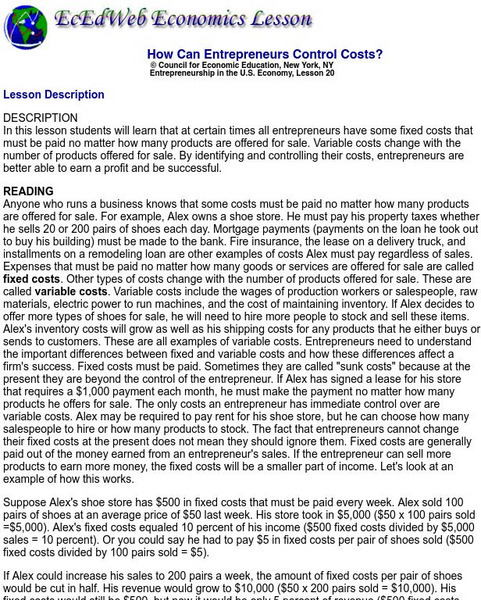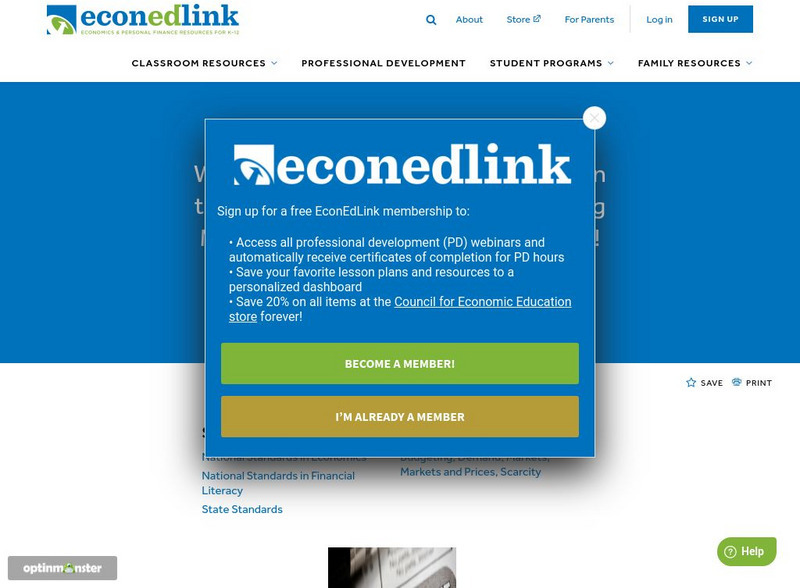Council for Economic Education
Econ Ed Link: Babysitter Shortage in Washington, d.c.
What is responsible for the shortage of babysitters in Washington, DC? Identify the parts of the article which indicate a decrease in supply and an increase in demand.
Council for Economic Education
Econ Ed Link: Tapped Dry: How Do You Solve a Water Shortage?
Economists do not operate in a vacuum. If an economist is going to suggest that the price of a good needs to be increased, he or she needs to consider who will bear the increase in costs. Will the costs be distributed equally or will one...
Council for Economic Education
Econ Ed Link: What Happened to Railroads?
Between the Civil War and World War II, railroads were one of the nation's most important businesses and an integral part of people's lives. In this instructional activity, students assume the role of detectives investigating why the...
Council for Economic Education
Econ Ed Link: Collecting for Fun . . . And Profit?
Art, baseball cards, coins, comic books, dolls, jewelry and stamps are just a few examples of the many things people collect. While some people collect for fun, others hope to profit. In this lesson, students explore how supply and...
Council for Economic Education
Econ Ed Link: What Causes Inflation?
This lesson explores different types of inflation and terms associated with this economic concept. You may have heard relatives talk about the good old days when a dollar would buy something. What happened to that dollar? Why won't it...
Council for Economic Education
Econ Ed Link: Widget Production: Producing More Using Less
Through this economics lesson you will learn about widget production. One of the tasks is to see how productivity can help solve problems.
Council for Economic Education
Econ Ed Link: Deregulation and the California Utilities
"The verdict is in: California's experiment with energy deregulation is not just a mess; it's a certifiable failure, according to everyone from the state governor to the very utilities that initially backed the scheme." This is how...
University of Nebraska Omaha
University of Omaha: Lesson Plan: Why Do I Want All This Stuff? [Pdf]
This lesson plan addresses consumer demand and advertising. Indicated for grades 3 through 5.
Khan Academy
Khan Academy: The Market Model
This study resource will help students understand, and create, graphs that are critical skills in macroeconomics. This article reviews the market model. This resource is designed as a review for the AP Macroeconomics Test or a...
Council for Economic Education
Econ Ed Link: Phillips Curve
This lesson plan explores the relationship of unemployment to inflation in the 1960s and after. Learners will discover the short-run trade-off between inflation and unemployment when unemployment is less than its natural rate. Students...
Council for Economic Education
Econ Ed Link: Those Golden Jeans
Check out this informative economics lesson plan designed to review the three productive resources--natural resources, human resources, and capital resources--needed to produce goods and services.
University of Nebraska Omaha
Ec Ed Web: How Can Entrepreneurs Control Costs?
This economics lesson explores what influences producers to supply in regard to demand. It examines fixed and variable costs, how such costs can be reduced, and how they influence production. Includes printable worksheets.
Khan Academy
Khan Academy: Lesson Summary: Equilibrium in the Ad as Model
In this lesson summary review and remind yourself of the key terms and graphs related to a short-run macroeconomic equilibrium. Topics include how to model a short-run macroeconomic equilibrium graphically as well as the relationship...
Council for Economic Education
Econ Ed Link: Exchange Rates and Exchange: How Money Affects Trade
Students learn how currency values are set by supply and demand, and how changes in the value of currency affect international trade. Students then find the value of the Brazilian Real in 2000 and 2002, determine whether the currency has...
Council for Economic Education
Econ Ed Link: How the Crusades Led to the Finding of the New World
The lesson will help middle schoolers to discover the importance of the Crusades to the expansion of many European countries. Students will also be introduced to new products and find out why explorers were willing to risk all to locate...
Council for Economic Education
Econ Ed Link: On the Money
In this lesson, students explore what money is and how it differs around the world. They will compare U.S. currency with play money and with foreign currency. They will then use their knowledge to design their own money.
Council for Economic Education
Econ Ed Link: The Price of Gasoline: What's Behind It?
In this lesson, students investigate the variables that contribute to the cost of gasoline. They learn that while OPEC nations do influence the price of oil and thus the price of gasoline, other factors also influence the price.
Council for Economic Education
Econ Ed Link: Traditional Economies and the Inuit
The Inuit people of northern Canada provide an example of a traditional economy. For thousands of years, Inuit parents have taught their children the survival skills needed to survive in the Arctic Circle's severe climate. Students will...
Council for Economic Education
Econ Ed Link: Wages and Me
Students explore the reasons for differences in the wages for several occupations. Then students are guided through the Bureau of Labor Statistics website to find information about their potential careers and wage rates nationally and in...
Council for Economic Education
Econ Ed Link: What Is Competition?
Explore the world of competition in business through this informative lesson plan.
Council for Economic Education
Econ Ed Link: National Parks: Only You Can Prevent the Coming Crisis
What do you think of when you think of the National Parks System? Do you think of the majesty of the Grand Canyon and the redwoods of Northern California? Or does the serenity of Cape Cod and the Everglades come to mind?
Council for Economic Education
Econ Ed Link: What Inefficiencies Lurk in Rent Controlled Housing Markets?
Imagine that you've just graduated from college and have been offered a position with a firm in New York City. You can't wait to start living in your own apartment! Explore the housing market and how it works.
Alabama Learning Exchange
Alex: Producers and Consumers
This instructional activity will teach the difference between producers and consumers. It provides an interactive way for students to get involved and actually become producers and consumers.
Social Science Education Consortium
Ssec: Minimum Wage: Does Raising the Rate Help Young Workers? [Pdf]
This investigation will help students examine issues related to the minimum wage, including: What does economic theory suggest will result in minimum-wage earnings and employment if the minimum wage is increased? Does an increase in the...
Other popular searches
- Economics Supply and Demand
- Economics Supply Demand
- Economics Supply and Demand
- Economics Supply & Demand
- Economics: Supply Demand
- Economics Supply and Demand









